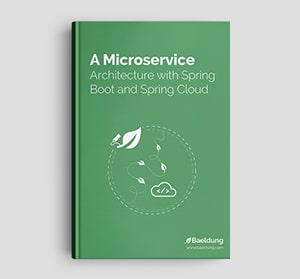1. Overview
In this article, we’ll discuss how to bootstrap Hibernate 6 with Spring using both Java and XML configuration.
This article focuses on Spring MVC. Our article, Spring Boot with Hibernate, describes how to use Hibernate in Spring Boot.
2. Spring Integration
Bootstrapping a SessionFactory with the native Hibernate API is a bit complicated and would take us quite a few lines of code (look at the official documentation in case you need to do that).
Fortunately, Spring supports bootstrapping the SessionFactory, so we only need a few lines of Java code or XML configuration.
3. Maven Dependencies
Let’s get started by first adding the necessary dependencies to our pom.xml:
<dependency>
<groupId>org.hibernate</groupId>
<artifactId>hibernate-core</artifactId>
<version>6.5.2.Final</version>
</dependency>
The spring-orm module provides the Spring integration with Hibernate:
<dependency>
<groupId>org.springframework</groupId>
<artifactId>spring-orm</artifactId>
<version>6.0.11</version>
</dependency>
For the sake of simplicity, we’ll use H2 as our database:
<dependency>
<groupId>com.h2database</groupId>
<artifactId>h2</artifactId>
<version>2.1.214</version>
</dependency>
Finally, we are going to use Tomcat JDBC Connection Pooling, which fits better for production purposes than the DriverManagerDataSource provided by Spring:
<dependency>
<groupId>org.apache.tomcat</groupId>
<artifactId>tomcat-dbcp</artifactId>
<version>9.0.80</version>
</dependency>
4. Configuration
As mentioned before, Spring supports us with bootstrapping the Hibernate SessionFactory.
All we have to do is define some beans and a few parameters.
With Spring, we have two options for these configurations: Java-based and XML-based.
4.1. Using Java Configuration
For using Hibernate 6 with Spring, we have to define beans for LocalSessionFactoryBean, DataSource, PlatformTransactionManager, and some Hibernate-specific properties.
Let’s create our HibernateConfig class to configure Hibernate 6 with Spring:
@Configuration
@EnableTransactionManagement
public class HibernateConf {
@Bean
public LocalSessionFactoryBean sessionFactory() {
LocalSessionFactoryBean sessionFactory = new LocalSessionFactoryBean();
sessionFactory.setDataSource(dataSource());
sessionFactory.setPackagesToScan(
{"com.baeldung.hibernate.bootstrap.model" });
sessionFactory.setHibernateProperties(hibernateProperties());
return sessionFactory;
}
@Bean
public DataSource dataSource() {
BasicDataSource dataSource = new BasicDataSource();
dataSource.setDriverClassName("org.h2.Driver");
dataSource.setUrl("jdbc:h2:mem:db;DB_CLOSE_DELAY=-1");
dataSource.setUsername("sa");
dataSource.setPassword("sa");
return dataSource;
}
@Bean
public PlatformTransactionManager hibernateTransactionManager() {
HibernateTransactionManager transactionManager
= new HibernateTransactionManager();
transactionManager.setSessionFactory(sessionFactory().getObject());
return transactionManager;
}
private final Properties hibernateProperties() {
Properties hibernateProperties = new Properties();
hibernateProperties.setProperty(
"hibernate.hbm2ddl.auto", "create-drop");
hibernateProperties.setProperty(
"hibernate.dialect", "org.hibernate.dialect.H2Dialect");
return hibernateProperties;
}
}
4.2. Using XML Configuration
As a secondary option, we can also configure Hibernate 6 with an XML-based configuration:
<?xml version="1.0" encoding="UTF-8"?>
<beans xmlns="...">
<bean id="sessionFactory"
class="org.springframework.orm.hibernate5.LocalSessionFactoryBean">
<property name="dataSource"
ref="dataSource"/>
<property name="packagesToScan"
value="com.baeldung.hibernate.bootstrap.model"/>
<property name="hibernateProperties">
<props>
<prop key="hibernate.hbm2ddl.auto">
create-drop
</prop>
<prop key="hibernate.dialect">
org.hibernate.dialect.H2Dialect
</prop>
</props>
</property>
</bean>
<bean id="dataSource"
class="org.apache.tomcat.dbcp.dbcp2.BasicDataSource">
<property name="driverClassName" value="org.h2.Driver"/>
<property name="url" value="jdbc:h2:mem:db;DB_CLOSE_DELAY=-1"/>
<property name="username" value="sa"/>
<property name="password" value="sa"/>
</bean>
<bean id="txManager"
class="org.springframework.orm.hibernate5.HibernateTransactionManager">
<property name="sessionFactory" ref="sessionFactory"/>
</bean>
</beans>
As we can easily see, we’re defining exactly the same beans and parameters as in the Java-based configuration earlier.
To bootstrap the XML into the Spring context, we can use a simple Java configuration file if the application is configured with Java configuration:
@Configuration
@EnableTransactionManagement
@ImportResource({"classpath:hibernate6Configuration.xml"})
public class HibernateXMLConf {
//
}
Alternatively, we can simply provide the XML file to the Spring Context if the overall configuration is purely XML.
5. Usage
At this point, Hibernate 5 is fully configured with Spring, and we can inject the raw Hibernate SessionFactory directly whenever we need to:
public abstract class BarHibernateDAO {
@Autowired
private SessionFactory sessionFactory;
// ...
}
6. Supported Databases
Unfortunately, the Hibernate project doesn’t exactly provide an official list of supported databases.
That being said, it’s easy to see if a particular database type might be supported; we can look at the list of supported dialects.
7. Conclusion
In this quick tutorial, we configured Spring with Hibernate 6 – with both Java and XML configuration.
The code backing this article is available on GitHub. Once you're
logged in as a Baeldung Pro Member, start learning and coding on the project.















